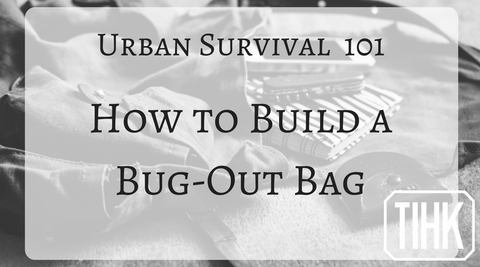A bug-out bag is an important element of everyday preparedness. You can go down a pretty deep rabbit hole of various types of bags you can build, including get-home bags which you would keep at your place of employment, emergency bags specifically for keeping in your car, and go-bags for your children. But today we’re going to focus simply on the elements of the basic bug-out bag, which is the bag you’ll grab in the event that you need to evacuate your home, and quick. Let’s assume for the purposes of this article that you’re building a bag only for yourself.

What Kind of Bag Should I Use?
The kind of bag you choose will up to a certain point depend on your individual taste, although it should conform to a few standards:
- Comfortable. You don’t know how far you may need to go on foot, so you’ll thank yourself for finding something with cushioned straps and an ergonomic design.
- Inconspicuous. The last thing you need in an emergency situation is to draw unwanted attention to yourself and what gear you might have in your bag. Find something in neutral colors without patches or insignia. It should not look overly tactical, because this broadcasts that you’re prepared, which can turn you into a target. Follow the Gray Man philosophy of a forgettable appearance.
- Well-organized. Find something with a decent network of pockets for good organization. A bag with a single deep pocket where everything is jumbled together will not be helpful if you need to find something quickly.
What do I Put in my Bug-Out Bag?
The idea of a bug-out bag is that it contains everything you need to get you out of dodge as quickly and efficiently as possible. The typical rule of thumb is to pack enough supplies to last you for three days. This will vary depending on where you live and your personal lifestyle and habits, but some essentials are:
- An extra set of keys for your home and vehicle(s).
- Identification.
- Water. Start with a couple bottles, and eventually add a water purification device.
- High-energy, low-volume snacks such as nuts and beef jerky.
- A first-aid kit
- Extras of any prescription medications you take
- Cash
- Fire-starting materials
- Knife/multi-tool
- Extra clothing. At the very least, a few changes of underwear and socks. It is especially important to keep your feet dry and warm.
Final Thoughts
- Only include items that you are likely to use. Don’t bother to include a fishing kit if you’re not anywhere near a body of water.
- Only include survival gear that you know how to use.
- A bug-out bag is not intended to contain everything you need to survive for months in the wilderness; it’s a short-term solution to a temporary emergency situation.
Get started with urban survival gear to include in your bug-out bag. Check it out here.

